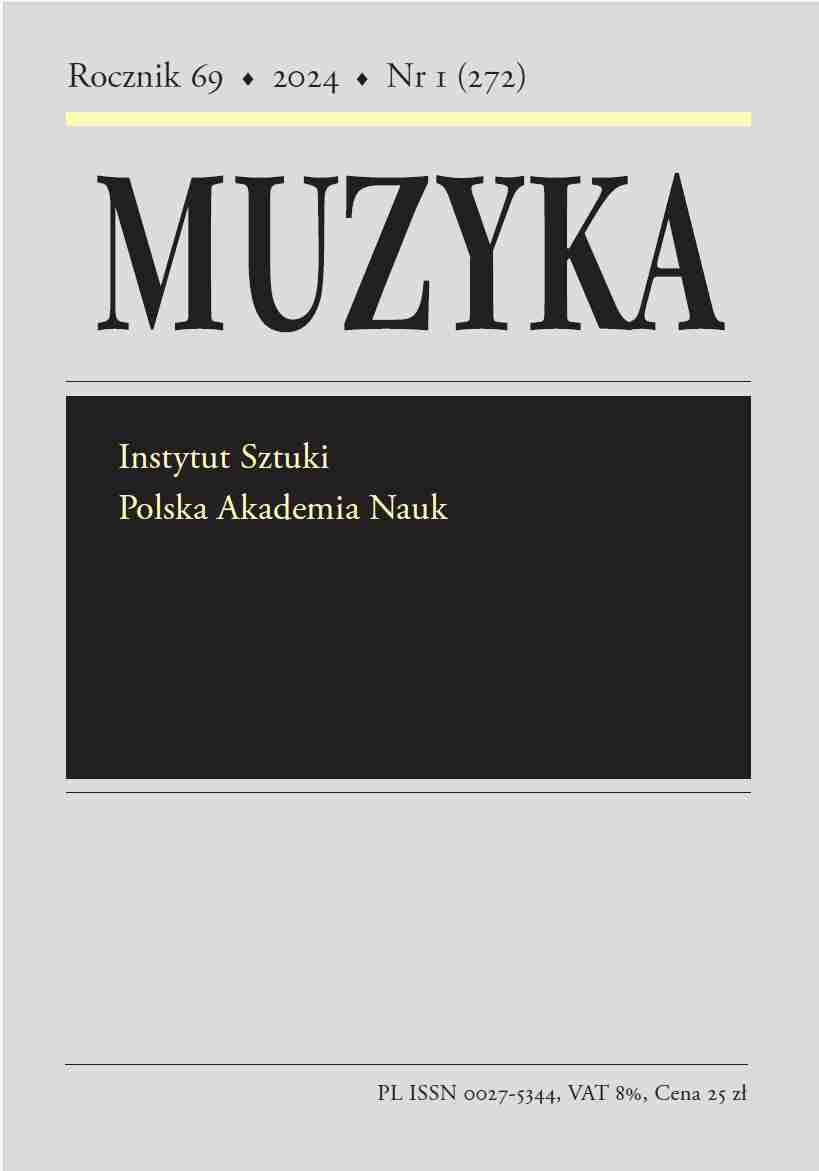A Textless Anonymous Setting of a Psalm of David in the Kražiai Organ Tablature. Text Reconstruction and Attempted Attribution
Tomasz Jasiński
Maria Curie-Sklodowska University, Lublin (Poland)
https://orcid.org/0000-0002-5916-6254
Abstract
This article concerns an anonymous Psalm of David entered in a seventeenth-century organ tablature from Kražiai (Lithuania). It is a four-part composition ‘a voce piena’, quite long (96 bars), in two sections, written in vocal notation in the form of a score, but without a verbal text.
In the first section of the article, the author demonstrates that this is a setting of the first Psalm of David in a poetic rendition by Jan Kochanowski (‘Szczęśliwy, który nie był miedzy złemi w radzie’ / ‘Blessed is the Man Who Walks Not in the Counsel of the Wicked’), based on the melody of the same psalm found in Petrus Artomius’ ‘Cantional’ of 1640. In the transcription presented here, no real difficulty was encountered with underlaying Kochanowski’s text. Only in some sections (e.g. bars 57–85) was a degree of intuition required. The Psalm of David stands out in several respects: a motet with vernacular text (a generic novelty in early Polish music), it is a previously unknown motet setting of verse by Kochanowski, distinguished by impeccable counterpoint, excellent voice-leading, a full sound, clear tonal relations, motivic unity and rhythmic-textural diversity, as well as expressive coherence in the correlation of words and music.
In the second part of the article, the author hypothesises that the Psalm of David may have been composed by Mikołaj Gomółka (1535‒after 1591) and presents a comparative analysis between this work and Gomółka’s ‘Melodie na Psałterz polski’ (Melodies for the Polish Psalter). The author lists numerous differences between the two, but also points to various affinities and similarities in the melody, rhythm, harmony and other elements which seem to support the thesis that this work was written by Gomółka. There is no unequivocal conclusion to this research study; instead, it leaves the reader with an intriguing question.
References
Dobrzańska-Fabiańska, Zofia. Spór o role ‘modus’ i ‘tonalité’ w sztuce kompozycji XVI i początku XVII wieku. Kraków: Musica Iagellonica, 2013.
Google Scholar
Gomółka, Mikołaj. Melodie na Psałterz polski. Facsimile pierwodruku, wyd. Mirosław Perz. Kraków: PWM, 1981.
Google Scholar
Gomółka, Mikołaj. Melodie na Psałterz polski przekładania Jana Kochanowskiego. Transkrypcja, wyd. Mirosław Perz, opr. krytyczne tekstu Jerzy Woronczak. Kraków PWM, 1983.
Google Scholar
Jasiński, Tomasz. „Anonimowy motet Exsultate gaudete laeti omnes kompozycją Gorczyckiego?”. Annales Univeritatis Mariae Curie-Skłodowska, Sectio L, Artes 10, nr 1 (2013): 77–111.
DOI: https://doi.org/10.2478/v10075-012-0020-8
Google Scholar
Jasiński, Tomasz. „Rekonstrukcja warstwy słownej pieśni Słuchaj, co żywo zapisanej w tabulaturze organowej z Kroż”. Muzyka 66, nr 1 (2021): 169–179.
DOI: https://doi.org/10.36744/m.802
Google Scholar
Liber Organistarum Collegii Crosensis Societatis Jesu, wyd. Laima Budzinauskienė, Rasa Murauskaitė. Warszawa: Wydawnictwo Naukowe Sub Lupa, 2017 (= Fontes Musicae in Polonia, Seria B, 2).
Google Scholar
Ostaszewska, Ewa. „Kochanowski Jan”. W: Encyklopedia Muzyczna PWM. Część biograficzna, red. Elżbieta Dziębowska. T. 5, 114–115. Kraków: PWM, 1997.
Google Scholar
Perz, Mirosław. Melodie na Psałterz polski Mikołaja Gomółki. Interpretacje i komentarze. Kraków: PWM, 1988.
Google Scholar
Perz, Mirosław. Mikołaj Gomółka. Monografia. Kraków: PWM, 1981.
Google Scholar
Przybyszewska-Jarmińska, Barbara. Barok, część pierwsza: 1595–1696. Warszawa: Sutkowski Edition, 2006 (= Historia muzyki polskiej 3).
Google Scholar
Wind, Edgar. „Krytyka znawstwa”, przekł. Maria Klukowa. W: Pojęcia, problemy, metody współczesnej nauki o sztuce, red. Jan Białostocki, 170–192. Warszawa: Wydawnictwo Naukowe PWN, 1976.
Google Scholar
Authors
Tomasz JasińskiMaria Curie-Sklodowska University, Lublin Poland
https://orcid.org/0000-0002-5916-6254
Statistics
Abstract views: 494PDF downloads: 358
License
Copyright (c) 2021 Tomasz Jasiński

This work is licensed under a Creative Commons Attribution-NonCommercial-NoDerivatives 4.0 International License.
The author grants the publisher a royalty-free nonexclusive licence (CC BY 4.0) to use the article in Muzyka, retains full copyright, and agrees to identify the work as first having been published in "Muzyka" should it be published or used again (download licence agreement). By submitting an article the author agrees to make it available under CC BY 4.0 license.
Articles from 2018/1 to 2022/3 were published under a Creative Commons license CC BY-NC-ND 4.0. During this period the authors granted the publisher a royalty-free nonexclusive license (CC BY-ND 4.0) to use their article in "Muzyka", retained full copyright, and agreed to identify the work as first having been published in our journal should it be published or used again.
Most read articles by the same author(s)
- Tomasz Jasiński, Reconstructing the Text of the Song ‘Słuchaj, co żywo’ from the Kražiai Organ Tablature , Muzyka: Vol. 66 No. 1 (2021)
- Tomasz Jasiński, Anna Ryszka-Komarnicka, 'Księga Judyty' w oratoriach włoskich epoki baroku, Warszawa 2017 , Muzyka: Vol. 65 No. 1 (2020)
- Tomasz Jasiński, Zofia Dobrzańska-Fabiańska, Spór o rolę „modus” i „tonalité” w sztuce kompozycji XVI i początku XVII wieku, Kraków 2013 , Muzyka: Vol. 63 No. 3 (2018)
- Tomasz Jasiński, Dwie msze ad imitationem z rękopisu Kk I.1. Josquin des Prez/K. Borek(?): „Missa mater matris”. P. Certon: „Missa le temps qui court”, wyd. E. Zwolińska, Kraków 2016; Tomasz z Szadka: dwie msze z rękopisu Kk I.1. i motet, wyd. P. Poźniak, Kraków 2016 , Muzyka: Vol. 63 No. 3 (2018)










